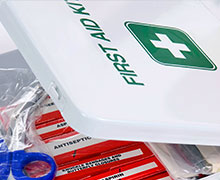First Aid Kits for Home and Away
You can download this article as a PDF (English, Spanish).
Are you ready?

Having a well-stocked first aid kit handy will help you take care of injuries at home and on the go. You can buy a first aid kit or make one out of a lunch box, tote bag or tackle box.
Kit contents
Information:
- Emergency phone numbers: 911, Poison Center, doctor, dentist and crisis line
- First aid book
Supplies:
- Band-Aids in assorted sizes
- Gauze pads and rolled gauze
- Adhesive tape
- Instant cold pack (disposable)
- Elastic roller bandage, like an Ace bandage
- Safety pins
- Triangular bandage (to wrap injury or make an arm sling)
- Cotton swabs and balls
- Bottle of water
- Soap
- Antiseptic wipes
- Thermometer
- Flashlight with extra batteries
- Plastic gloves (2 pairs)
- Tweezers
- Scissors with rounded tips
- Space blanket or regular blanket (stored nearby)
Medicines:
- Acetaminophen, like Tylenol
- Ibuprofen, like Advil
- Aspirin (do not give aspirin to children under 12)
- Anti-itch medicine taken by mouth, like Benadryl (antihistamine)
- Electrolyte solution, like Pedialyte
- Calamine lotion
- Hydrocortisone cream
- Antibiotic cream
- Aloe vera gel
- Saline wash
Tips for use
- Keep this list with your kit. Check it yearly, and replace missing and old items.
- Keep a kit in your home and in each car.
- Know the location of the first aid kit where you work.
- Remember to bring a first aid kit on trips.
- Show your babysitters and older children where the kit is.
- Keep the kit where adults can easily reach it, but young children can’t.
- Post the number for the Poison Center near each phone and add it to your contacts in your cell phone: 800-222-1222. The American Academy of Pediatrics recommends that syrup of ipecac no longer be used in the home to treat poisoning.
- Consider taking a first aid and CPR class. See our class options, or contact your local fire department, hospital or American Red Cross chapter to find out about their classes.
- Consider keeping a disaster supplies kit with your home first aid kit.

